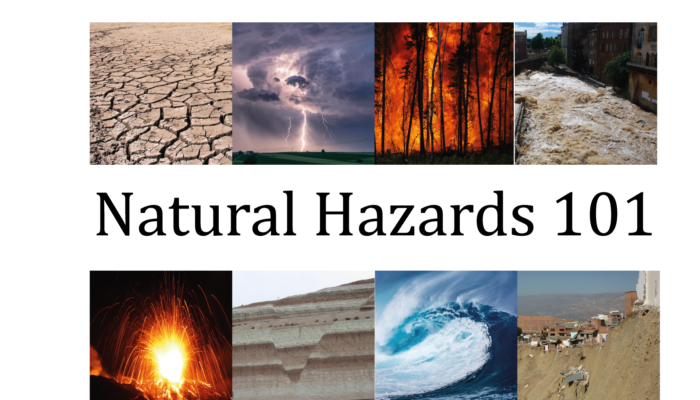
With the Natural Hazards 101 series, we meant to bring our readers closer to the terminology often used in the field of natural hazards, but that may not be so familiar. We started defining the very concept of hazard and natural hazard. We moved then to the concept of risk, which brought us to define exposure and vulnerability. In this episode, we will digest the disaster terminology provided by the United Nations Office for Disaster Risk Reduction that is punctuated by the different terms used to capture each phase of a disaster.
Disaster a serious disruption of the functioning of a community in a specific period of time determined as a function of exposure, vulnerability and capacity, leading to human, material, economic and/or environmental losses and impacts. Having a disaster loss or damage is different from the disaster impact within the disaster terminology because the former is always negative and describes the amount of destruction of physical assets, disruption of basic services and damages to livelihood sources in the affected area. The latter, disaster impact, includes positive and negative effects expanding the traditional economic and material impact by including the physical, mental and social wellbeing spheres. It’s important to use the word emergency instead of disaster when it refers to biological, medical or technological hazard, which does not seriously disrupt the functioning of entire communities (be aware that these are common definitions, but there are exceptions).
The disaster cycle or the disaster life cycle illustrates the ongoing process by which risk managers and governments plan for and reduce the impact of disasters, react with business and civil society during and immediately following a disaster, and take steps to recover after a disaster has occurred. It consists of four steps (even if there is a heated debate on the number and the definition of those): (i) mitigation, (ii) preparedness, (iii) response, and (iv) recovery.

Fig. 1 The disaster cycle. Source: Flanagan et al. 2011
Mitigation: The adverse impact (in terms of severity or scale sometimes) of natural hazards can be lessened (but not fully removed) by using mitigation measures. They are strategies and actions divided into engineering constructions (structural measures), environmental and social policies, and public awareness (nonstructural measures). Disaster prevention is often used as a synonym; instead, it expresses the intention to completely avoid potential impacts of hazardous events or their consequences (preventing secondary hazards -contamination of water, for example- after a primary hazard -a flood, for example). Disaster prevention actions aim at reducing vulnerability and exposure in such contexts where as a result, the risk of disaster is removed.
Preparedness: The knowledge and capacities to anticipate, respond and recover from the impacts of disasters (or the likely occurrence) developed by governments, organizations, communities and individuals. Preparedness actions(including contingency planning, stockpiling of equipment and supplies, the development of arrangements for coordination, evacuation and public information, and associated training and field exercises) are fundamental for disaster management and disaster risk reduction (DRR). It is important to note that DRR is the policy objective of disaster management and works with concrete priorities and targets according to the global agenda ‘Sendai Framework for Disaster Risk Reduction 2015-2030’. Preparedness actions must be supported by formal institutional, legal and budgetary capacities and are based on a sound analysis of disaster risks and good linkages with early warning systems. Early warning systems are a set of hazard monitoring activities, risk assessment plans and communication and preparedness actions that can be effective if they involve people and communities. If there is a constant state of preparedness (that for low probability hazards is not always easy to achieve), early actions are enabled and facilitated by public education and awareness of risk (including disseminating messages and warnings timely).
Response: Response, also called disaster relief, are those actions taken directly before, during or immediately after a disaster to save lives, reduce health impacts, ensure public safety and meet the basic subsistence needs of the people affected. Response actions are efficient when there are risk-informed preparedness measures in place at any level of society. The institutional elements of response often include providing emergency services and assistance (also on a volunteer basis) by public and private sectors.
Recovery: The restoring or improving livelihoods, health, and economic, physical, social, cultural and environmental assets, systems and activities, of a disaster-affected community, including build back better. The division between the recovery stage and response phase is not clear-cut; for example, considering those response actions, such as the supply of temporary housing and water supplies, may extend well into the recovery stage. However, in the recovery stage, we may also consider the medium and longer-term rebuild of infrastructures following sustainable and resilient reconstruction plans (also called disaster reconstruction or rehabilitation if it consists of the restoration of basic services and facilities).
References
Flanagan, Barry E.; Gregory, Edward W.; Hallisey, Elaine J.; Heitgerd, Janet L.; and Lewis, Brian (2011) “A Social Vulnerability Index for Disaster Management,” Journal of Homeland Security and Emergency Management: Vol. 8: Iss. 1, Article 3. DOI: 10.2202/1547-7355.1792
Read episode 1: What is a -natural- hazard?
Read episode 2: The concept of risk.
Post edited by Valeria Cigala and Asimina Voskaki

Taraji pendo
Useful content.